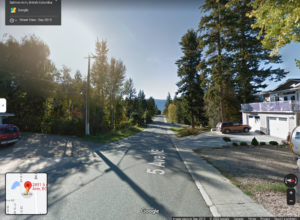Local Environmental History – Salmon Arm
February 28, 2022 By: Elizabeth Beattie
Location: {50.7036631,-119.2518658}

I live just up the hill from the heart of Salmon Arm, the largest town in the Shuswap are of British Columbia, Canada. Unfortunately, my neighbourhood up the hill, that is shown in the picture attached, was all forested mountain throughout the early history before and for a long time after it was settled by Europeans; therefore, I will focus on the town of Salmon Arm. The First Nations Secwepemc people habited the entire Shuswap area first though before European settlers arrived; they hunted and fished this area through the bodies of waters and forests (1).
As we have seen through other aspects of history, the Indigenous are not treated well. This treatment is shown well once Europeans arrived in this area. The first blow to First Nations people occurred when a province-wide smallpox outbreak began in 1862, killing close to a third of their population to this disease (3). The second major blow to First Nations people was land ownership. When the Europeans’ concept of land ownership came into place, the original First Nations habitants located in the Shuswap and specifically in Salmon Arm where the Europeans wanted to settle, were relegated to reserves scattered through the west of town, where the soil was poor and living conditions of poor quality (4).
Individuals had a hard time understanding why anyone would settle into this area we call Salmon Arm; this area was densely treed and burdened with mosquitos in the summer months (5). Despite this, the official European settler arrived in 1888, just after the development of the Canadian Pacific Railway through the area (3). Europeans first named this town after the southwest are of the Shuswap Lake because of the large numbers of Salmon that swam up the creeks and empty into the lake (3). This was one of the reasons these Europeans decided to settle in Salmon Arm, the abundance of not only Salmon but also for other animals in the dense forests. The past and present is and was abundant with many diverse species of fish, deer, beavers, otters, birds (specifically the Western Grebes which are abundant on our local marshland shores presently). With the European settlers though came several invasive species of which have increased substantially over time and are now on a long list on the Salmon arm IMPA Priority Plant list (6).
Another reason why European’s settlers moved into this area was for the greater annual rainfall that occurred, which allowed them to grow food with minimal irrigation techniques (3). There were still many challenges for these new individuals though. One impact came with the forest industry when the spring log drive in the Salmon River scoured Salmon spawning beds. Another challenge that occurred was with fruit and vegetable output which was a success at first but over time was faced with inconsistent weather, competition and expense of shipping produce, the calamites in 1894, massive flooding, and a huge fire on Mt. Ida that destroyed the sawmill and many farms (3). Eventually, though, the settlers began to understand these challenges and adjusted accordingly. In 1907 the Salmon Arm Farmers’ Exchange occurred, shipping many boxes of produce as well as harvesting for the local Salmon Arm Fall Fair (3). Less than a decade later, the local dairy farmers formed a creamery association in 1915 that eventually turned into its own processing facility which also allowed for the eventual shipment of dairy (3).
One of the biggest reasons why steady settlement occurred here was the commitment to community and cooperation (all of which our town still has today) which pushed settlers to build roads, set up schools and churches, develop community associations, build a fire hall, a post office, a general store, and the first bridge across the Salmon River, and the establishment of the local sawmill, all mostly within less than a decade starting with only 200 settlers to eventually reaching 1200 (4). 1890 was the year Salmon Arm first began; 1905 our municipality was created; 1912 we got our first mayor, R.K. Scales, and despite an economic downturn occurring, most of the civic structures of our town were built in the 1920’s and 1930’s (4). Eventually, with the opening of the Rogers Pass Highway in 1962, Salmon Arm flourished from a small agricultural town into a vibrant community for tourism, causing an increased population (4).
Today, agriculture still plays a very important role in our community which is shown in the large number of farms we have for produce, meat, and dairy, as well as the increasing development of agrotourism (4). Our economy has also variegated into a mix of agriculture, forestry, commerce, manufacturing, and tourism (4). Our community over time has also gained more and more stewardship actions, including community garden, community learning garden, blue box recycling, composting of yard and kitchen waste, introduction of Forest Practices Code (developed to have sustainable protective forest practices), monitoring of streams and fish habitats, community watershed planning, and soil, water, and energy conservation (2). I am proud of how far our community has come and happy that I get to live in such a beautiful place.
End Notes:
- Alexa Dagan & Deborah Chapman, “City on the Lake: Salmon Arm’s Early History,” On This Spot, On This Spot Enterprises Inc., Accessed February 24, 2022, https://onthisspot.ca/cities/salmonarm/community
- Jennifer Nener et al., “Watershed Stewardship: A Guide for Agriculture,” Government of British Columbia, Canadian Cataloguing, Accessed February 24, 2022, https://a100.gov.bc.ca/pub/eirs/finishDownloadDocument.do?subdocumentId=4182
- Jim Cooperman, “Salmon Arm’s History of Cooperation and Community,” Shuswap Passion, inTechrity, Accessed February 24, 2022, https://shuswappassion.ca/history/salmon-arms-history-of-cooperation-and-community/
- Robert Hobson & Lorri Dauncey, “Heritage Strategy: The City of Salmon Arm,” City of Salmon Arm, Published January 2009, https://www.salmonarm.ca/DocumentCenter/View/108/Salmon-Arm-Heritage-Strategic-Plan?bidId=
- “Salmon Arm,” BritishColumbia.com, Shangaan Webservices Inc, Accessed February 24, 2022, https://britishcolumbia.com/plan-your-trip/regions-and-towns/thompson-okanagan/salmon-arm/
- “Salmon Arm IPMA Priority Plant List,” Columbia Shuswap Invasive Species Society, Modified April 2021, https://columbiashuswapinvasives.org/wp-content/uploads/2021/05/Salmon-Arm-IPMA-Priority-Plant-List.pdf